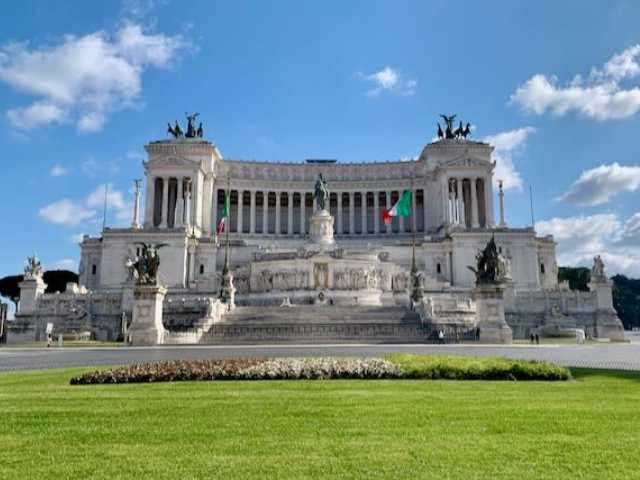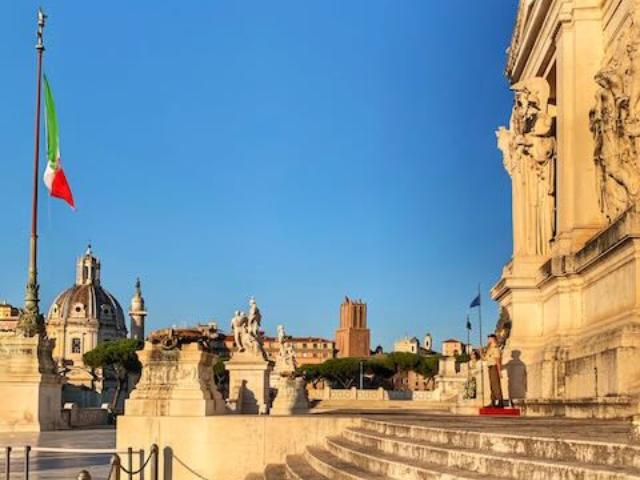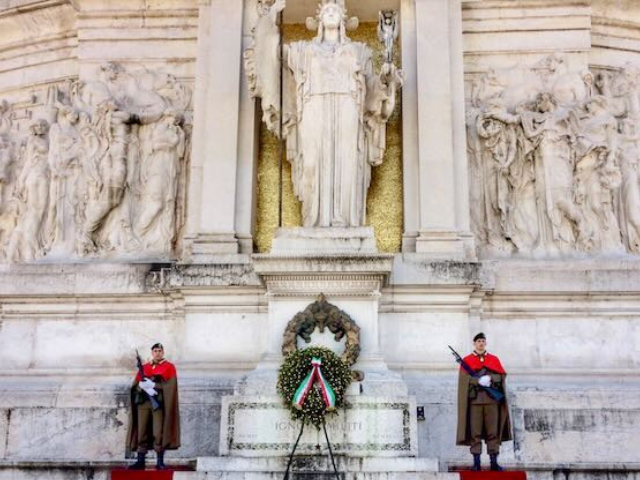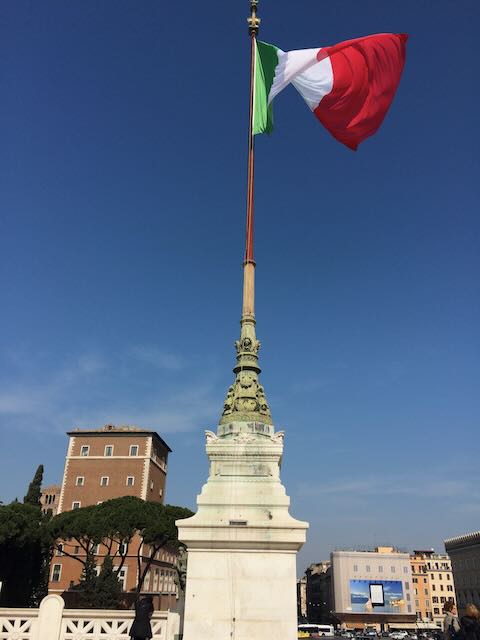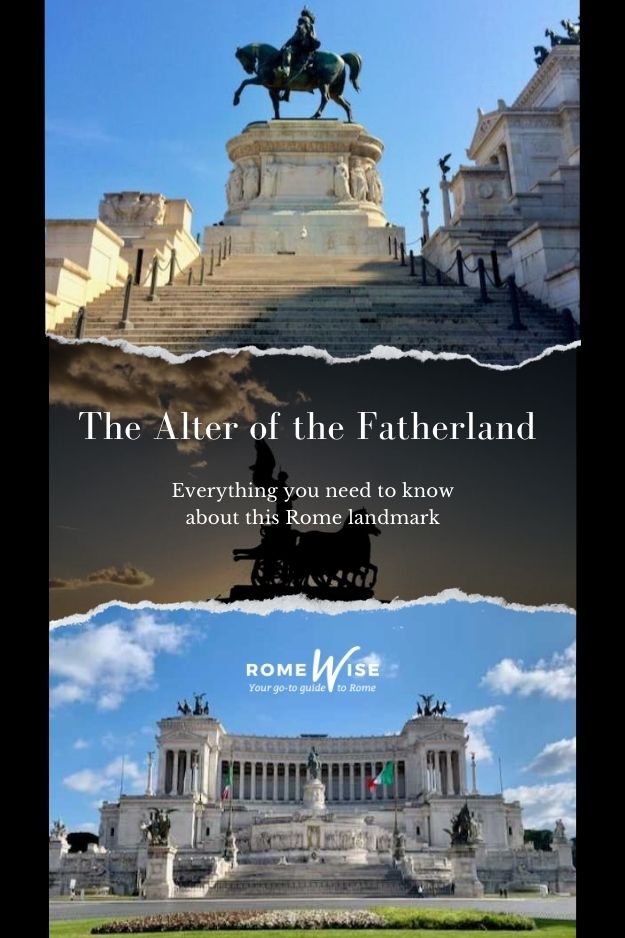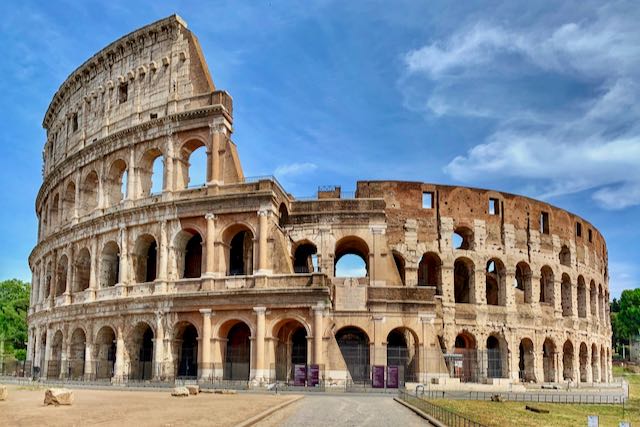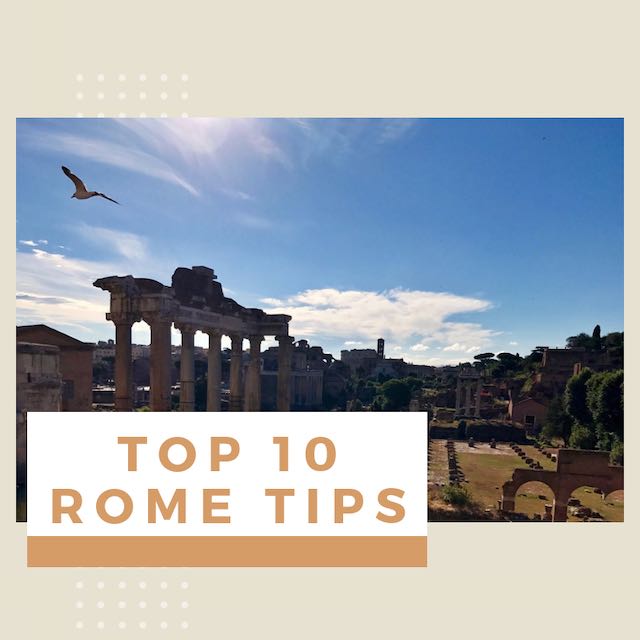- Sign up & get a FREE ebook Subscribe NOW!
- Romewise Home Page
- What to Do in Rome
- Altar of the Fatherland
Altar of the Fatherland Rome
The Altar of the Fatherland raises many questions.
Just what is that huge white building in the middle of Rome?
The one with the chariots on top?
Altar of the Fatherland - Everything you need to know
The Altar of the Fatherland is often nicknamed called "The Wedding Cake" and sometimes "The Typewriter", but as you might imagine, it has a more important meaning.
Its correct name is the Complesso Vittoriano, which means the Victorian Complex, and it was built to honor King Vittorio Emanuele II, the first king of a unified Italy.
(The Altar of the Fatherland is only one part of this complex.)
It's a monument you can easily visit and much of it is free.
There are plenty of things to see in and around the building, and its central location in Piazza Venezia makes it easy to include in your sightseeing itinerary.
On this page we'll go over:
- What is the Altare della Patria? Where is it?
- Is the Complesso Vittoriano a building from Ancient Rome?
- Is the Complesso Vittoriano a fascist building?
- Is the Vittoriano the biggest monument in Rome?
- When was the Victor Emmanuel II monument built?
- Why don't many Romans like the monument to Victor Emanuel II?
- What is inside the Victor Emmanuel monument?
- How can you visit the Victorian Complex? Is it worth visiting?
What is the Altare della Patria?
 The view of the Victor Emmanuel ii monument from the side gives you an idea of how large it is in comparison to the buildings around it
The view of the Victor Emmanuel ii monument from the side gives you an idea of how large it is in comparison to the buildings around itThe Altare della Patria, or altar of the fatherland, is a monument in Rome, Italy.
It's part of an enormous building called the Monument to Victor Emmanuel II, or Complesso Vittoriano.
What is the Complesso Vittoriano?
The Complesso Vittoriano was built to honor Vittorio Emanuele II, the first king of a unified Italy.
The monument was built not long after the "Risorgimento", which was the long push for Italian unification, fought between 1849 and 1870.
Because King Victor Emmanuel ii was the first king after the unification of Italy, this monument dedicated to him is also seen as a symbol of Italian Unity, a national landmark.
(But this does not mean that all Romans or even Italians like this building! Keep reading to find out why.)
The building is most accurately called the Complesso Vittoriano, or Victorian Complex because it is in fact made up of several sections with important dedications.
It has a neoclassic design that was modeled after ancient buildings including those inside the Roman Forum, but also Hellenistic sanctuaries, such as the Pergamon Altar and the Sanctuary of Fortuna Primigenia in Palestrina.
The colossal monument features Corinthian columns, fountains, sweeping stairways, a long portico composed of an imposing colonnade with two propylaea (monumental gateway typical of Ancient Greek architecture) on either end, and two quadrigas (chariots drawn by four horses each) on top.
Every year the Vittoriano hosts important national celebrations.
These are on Liberation Day (April 25), Day of the Republic (June 2), and Armed Forces Day (November 4.)
The President of Italy officiates and lays a wreath at the tomb of the unknown soldier.
Also, you can witness a flyover by the Italian Aeronautica Militare, the Italian Air Force, in which jets flown by the special team "Pattuglia Acrobatica Nazionale Frecce Tricolori" leave plumes of the colours of the Italian flag - green, white, red.
Italians often refer to the monument as the "Mole del Vittoriano", or just the "Vittoriano".
It's also often referred to as the "Altare Della Patria" even though that is technically only a small part of the entire complex.
🤙 Roaming in Rome? 📱
Get yourself an Italian eSIM for calls, messages and data when traveling here.
Save on data charges with plans from just 19€ from Holafly - our recommended eSIM provider - click here to find out more.
The Altar to the Fatherland
The Altare Della Patria, or altar of the Fatherland, is located in the center of the complex and is arguably the most important part.
It includes a statue of the goddess Rome and also a shrine to honour the tomb of the unknown soldier.
The tomb is inside the monument but one end of it faces outward and that part is guarded 24/7 by two Italian soldiers, rain or shine.
On either side of them are two eternal flames, a custom dating back to Ancient Rome.
Where is the Complesso Vittoriano?
The Complesso Vittoriano and its Altare della Patria are in Piazza Venezia, symbolically linking Ancient Rome with Modern Rome, thanks to the streets that emanate like spokes of a wheel from the piazza.
What is Piazza Venezia?
Piazza Venezia takes its name from the palazzo on one side of the square, Palazzo Venezia (Venice Palace.)
It was built by Pietro Barbo, a Venetian Cardinal who would become Pope Paul II (1461 - 1471.)
The Basilica of Saint Mark, the patron saint of Venice, is next to the palace.
Palazzo Venezia was once the embassy of the Republic of Venice in Rome.
The building and church are made in part with materials quarried from the Colosseum, which was a common practice before the 18th century.
The Fascist regime of Benito Mussolini used Palazzo Venezia as its headquarters.
Mussolini gave many of his speeches from the balcony of the Palazzo Venezia, including, perhaps most famously, his declaration of war against France and the United Kingdom on June 10, 1940 during World War II.
Taking one street from the monument, the Via dei Fori Imperiali, will bring you down the road of the Imperial Forums past the Roman Forum and straight to the Colosseum.
In the opposite direction, the Via del Corso will take you through Rome's Baroque district that includes the Spanish Steps, and straight to Piazza del Popolo on the other end.
🙌 See Rome from New Heights! 🙌
Discover Rome from every angle with this unique combination experience. Explore ancient artifacts at the Capitoline Museums, then soar to new heights with the Altar of the Fatherland elevator for a panoramic city view.
Is the Wedding Cake a building from Ancient Rome?
I remember the first time I visited Rome years ago. I assumed this imposing monument was from Ancient Rome.
(Obviously, now I know better!)
And even today, when I tell visitors that it's quite modern, they are often surprised, telling me that they too thought it was from Ancient Rome.
We could all be forgiven for thinking such a thing.
After all, the design is something of a neoclassical re-imagination of the Roman Forum (hence all the imposing white columns and Corinthian capitals.)
Anyway the answer is no.
This is not a building from Ancient Rome at all.
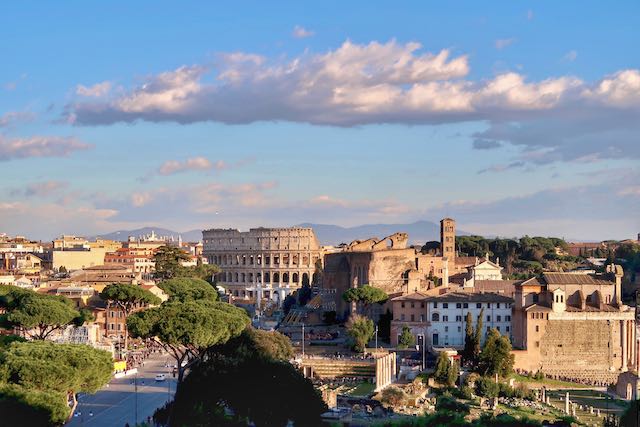 While you can see a lot of ancient Roman ruins from the Vittoriano, the building itself is much more modern!
While you can see a lot of ancient Roman ruins from the Vittoriano, the building itself is much more modern!The Victor Emmanuel II monument was built mostly between 1885 and 1911 to honor Victor Emmanuel II, the first king after the unification of Italy.
He is not, however, buried here.
He is buried, along with his son King Umberto I and Umberto's wife, Queen Margarita, in the Pantheon.
The monument was inaugurated in 1911 and completed in 1935.
Ready to plan your trip?
Book your train
Planning to travel between cities in Italy and other parts of Europe?
Use Trainline to see all the different options available across the different rail companies.
Find your hotel
Find your perfect place to stay in Rome.
Use Booking.com to choose between hotels, guesthouses, and self-catering apartments in neighborhoods throughout the Eternal City.
Buy your TurboPass
Purchase the convenient Turbopass and visit all of Rome's top attractions including the Colosseum, Pantheon, and Vatican.
With one handy pass, it's all included.
Is the Complesso Vittoriano a fascist building?
The Victor Emmanuel II monument is not a fascist building.
A slightly more detailed answer is that "fascist architecture" is a bit of an overly generic term.
The architecture people associate with Fascism in Rome, with stark, clean white lines, is called Rationalism.
Even so, we cannot say that the Victorian Complex is Rationalist architecture (we have plenty of Rationalist architecture in and near Rome.
But this is not one of the examples of it.)
The style could be considered eclectic.
Some people also consider it to be a prime example of kitsch.
In any case, the building has no real connection to Fascism other than the fact that Mussolini liked to hold speeches in Piazza Venezia where the monument is.
Is the Wedding Cake the biggest monument in Rome?
The monument is 135m (443 ft) wide, 130m (427 ft) deep, and 70m (230 ft) high.
This makes it the largest single modern monument in the city of Rome.
However, it is not the largest structure in Rome.
The largest ruin in Rome is in fact....not the Colosseum!
It's the Aurelian Walls.
Constructed out of brick-faced concrete, the walls are 3.5 m (12 feet) thick and 16 m (52 ft) tall.
They originally ran for 19 km (12 miles), and even today we still have 12 km (7.5 miles) of them standing nearly intact.
When and how was the Vittorio Emanuele monument built?
King Vittorio Emanuele II of Savoy died in 1878.
He was the last ruler of the Kingdom of Sardinia and the first king of Italy and Parliament decided to erect a monument in his memory to be forever remembered in the Eternal City.
The architect chosen was Giuseppe Sacconi.
Construction began in 1885.
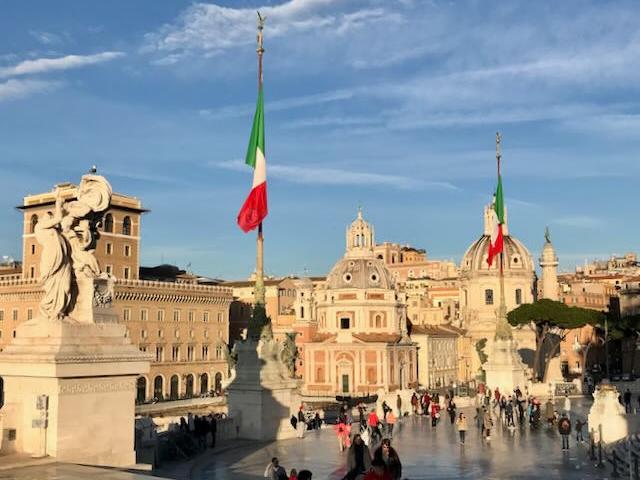 The size of the people versus the building shows you how gigantic this monument to King Vittorio Emmanueule is
The size of the people versus the building shows you how gigantic this monument to King Vittorio Emmanueule isBut it took some time for the works to even begin.
Large parts of Medieval and some of Ancient Rome had to be demolished.
(And this might give you a hint as to why many Romans don't like this building.)
During these demolitions, archeological finds would come to light, slowing or halting the works.
Another factor that caused the construction to take so long was the building materials.
Initially, they used Carrara white marble but the quantity needed meant that costs soared.
So they used Botticino from Brescia, which cost considerably less.
Sacconi died in 1905, so did not get to see his moment completed.
The complex was inaugurated on June 4, 1911, on the occasion of the Turin International world's fair and the 50th anniversary of Italian unification.
The equestrian statue of Vittorio Emanuele II was added the following year.
In 1921, the body of the Unknown Soldier, who represented those lost during the Great War, was buried in the complex.
As Fascism took hold in 1922 with Mussolini's March on Rome, the Vittoriano became the backdrop for events and parades that exalted the regime.
The Wedding Cake was covered with Fascist symbols and so became closely associated with the Fascist ideology which was of course, not the original intent of the building.
The monument was completed in 1935.
After World War II, the monument was stripped of all its Fascist symbols and it lost its lustre.
Many saw the monument as too self-aggrandizing.
Italians often associated "patriotism" with "nationalism", which was in turn associated with fascism and didn't like the idea of a monument celebrating the "fatherland."
It fell into disuse and disrepair until the year 2000 when President Carlo Azeglio Ciampi decided to restore it and bring the symbolism back to the original intent.
No matter what season you visit Rome, here are 4 essential things we recommend never leaving home without:
Disclosure: If you make a purchase through a link on this page, I may receive a small commission - at no extra cost to you. Thank you for supporting my site!
Why don't many Romans like the monument to Vittorio Emanuele II?
Tourists tend to gaze in awe at the Vittoriano.
Some Romans love it, too.
But quite a few don't.
There are a few reasons.
First, in order to create this behemoth of a building, large swathes of Rome had to be demolished.
Some parts of Ancient Rome along the via dei Fori Imperiali and on Capitoline Hill were destroyed.
The Alessandrino neighborhood that had sprung up in the area during the Middle Ages, and where Michelangelo once lived, was also demolished.
Can you imagine if somebody wanted to tear down part of Rome's ancient walls or even a whole neighborhood to build something today?
There would be outrage!
So this is one reason not all Romans were thrilled about the construction of this monument.
 Seeing how many buildings surround the Vittoriano it becomes clear that much must have been demolished to make room for it
Seeing how many buildings surround the Vittoriano it becomes clear that much must have been demolished to make room for itAnd if you visit, you might be able to see another reason why.
The monument is just enormous, somewhat out of proportion to its surroundings.
And the kind of white marble, which initially should have been from Carrara, (so-called “White of Carrara) was quarried instead from Brescia, as it was considerably cheaper.
And this stone (so-called “White Botticino) is a very stark, cold white, which makes the monument look unfriendly, if we can ascribe this emotion to a building.
Finally, the more recent (and inevitable) association with Mussolini, albeit fleeting, gives it a negative connotation.
The perfect 3-day itinerary in Rome
Trying to figure out how to organize your visit to Rome? I've got the perfect 3-day itinerary for first-time visitors (or those who have not been here in a while.) It works for a 2.5 day visit as well.
In my 3-day itinerary, you'll see all the major must-see Rome attractions like the Vatican, Colosseum, Trevi Fountain, Pantheon, Piazza Navona, Spanish Steps, Castel Sant'Angelo, and much more.
And if you have more time, or want suggestions for extra/other things to do, you'll find that there too.
Visit my page with the best 3-day itinerary in Rome for first-timers.
What is inside the Vittorio Emanuele II monument?
Since the Complesso Vittoriano represents the Italian nation, it is flanked by two fountains that represent the two seas bordering Italy.
The fountain representing the Tyrrhenian Sea is on the right-hand side as you face it, and the Adriatic Sea is on the left-hand side.
In front of the fountain with The Adriatic Sea, you can see remnants of a ruin from the 1st century BCE, which was somehow spared during demolitions.
When you first enter the monument from the front, you'll climb a staircase that will take you up several levels.
The first thing you may notice is the tomb to the unknown soldier, with the two soldiers guarding it and the eternal flame.
As you climb, you will come to the large equestrian sculpture of King Vittorio Emanuele II himself, for whom the monument is named.
Something not many people know is that upon completion of this monument, the workers had a meal inside the belly of the equestrian statue of the horse!
Yes!
They did.
You can see a photo here.
Climbing past the statue, you'll come to the main colonnade which is flanked by an imposing portico.
Each of the columns is topped with a statue that represents the 16 regions of Italy that existed when the monument was made (today there are 20 regions.)
This huge space is called the Piazza del Bollettino, named for the "bollettino", or Bulletin of Victory, a document signed on November 4, 1918, by General Armando Diaz, Supreme Commander of the Italian Royal Army, which signified Italy's victory in the first World War.
The words of this bulletin are engraved along the portico’s border.
Look carefully for the block of stone from Monte Grappa, which represents the First Battle of the Piave, an important moment of World War I for Italy.
The Victor Emmanuel Monument also has several things to see and do inside, including:
🔐 Peace of mind for your travels 🧳
Have you organized your travel insurance yet? Getting cover in place to protect against unforeseen circumstances should be at the top of your planning list so you can relax and enjoy your travels fully.
Check out our recommended travel insurance now.
Central Museum of the Risorgimento
This central museum houses artifacts and documents that show the transformation of the political scene in Italy in the 18th, 19th, and 20th centuries, leading up to the unification of Italy.
The collection consists mostly of photographs, letters, and other manuscripts, along with some clothing, personal effects, and weapons of some of the protagonists of this important moment in Italian history and the city of Rome.
The Imperial Forums Wing
This is where the Museum of the Risorgimento used to be.
For a time, temporary art exhibits were held here.
The space is currently being restored.
Sacrario delle Bandiere delle Forze Armate
The Shrine of Flags at the Vittoriano houses the War Flags of the dissolved Departments of the Army, Air Force, Carabinieri, and the Armed Corps of the State as well as the Combat Flags of the disarmed units of the Navy since 1935.
The Tomb of the Unknown Soldier is here, buried on November 4, 1921.
As of this writing, the site is temporarily closed to visitors. We do not know when it might reopen.
The Tomb of the Unknown Soldier
Previously, you could visit the lower areas and see the internal area of the monument where the Unknown Soldier’s tomb lies.
At this time, this area is closed to visitors.
 I took this photo on a visit some years ago, when the internal area of the Altare della Patria was open to visitors
I took this photo on a visit some years ago, when the internal area of the Altare della Patria was open to visitorsThe first terrace, Terrazzo Italia
This is the highest level you can visit without taking the elevator to the roof.
From here, you still get stunning 360-degree views of the city of Rome.
There is also a café with some indoor and some outdoor seating.
There are some seats overlooking the via dei Fori Imperiali and up towards the Palatine Hill.
 The cafe on a top terrace of the Vittoriano monument is a good place to take a break from all the steps!
The cafe on a top terrace of the Vittoriano monument is a good place to take a break from all the steps!An observation deck with amazing views of Rome
One of the most recent additions to the monument is an elevator that allows you to visit the very top, with arguably the best views in all of Rome.
 Taking the elevator (on the left of the picture) all the way to the top of the monument is well worth it for these views
Taking the elevator (on the left of the picture) all the way to the top of the monument is well worth it for these viewsFor a small fee (12€ at the time of this writing), you can take the elevator to the terrace where you can enjoy 360-degree views of Rome.
You'll also be able to spot many landmarks, thanks to panels that lay out what's in front of you.
And with viewfinders, you can get an even better look.
There is nothing like visiting this terrace at night and enjoying the sunset from there.
For more details about the monuments history and architecture, including all the allegories, the various architects who worked on this building, and more, you can visit the official page of the Vittoriano here.
How can you visit the Victor Emmanuel Monument?
The Complesso Vittoriano is open every day, from 9:30 am to 7:30 pm (last entry at 6:45 pm), except December 25 and January 1.
In summer, the monuments often open until late at night.
Check the official website for details.
The changing of the guard takes place every hour.
Visiting the main building on the outside
There are several layers to this building and different things to visit.
Some are free.
You used to be able to just walk up the steps and meander around at liberty.
Since reopening after Covid lockdowns, some things have changed.
First of all, the underground areas that include the Tomb of the Unknown Soldier and also the Sacrario delle Bandiere (Shrine of the Flags) are still closed.
Second of all, you must now enter one at a time through the main gate at street level and proceed up the right-hand side to explore what the monument holds.
You will exit down the opposite side, or sometimes they direct people down the internal stairs inside the whole structure.
Visiting the Vittorio Emanuele II monument on the roof and inside
To visit the panoramic terrace of the Altare della Patria, you must purchase Victor Emmanuel ii monument tickets.
This ticket also includes entry to the Museum of the Risorgimento, as well as the museum at Palazzo Venezia just adjacent to the monument in Piazza Venezia.
- 12€ - Adults
- 2€ - Everyone 18-25
- Free - Everyone under 18, anyone in a wheelchair and their caregiver, and for everyone on the first Sunday of the month (Free Sunday).
Is it worth visiting the Victor Emmanuel monument?
I think it's worth a visit to the Victor Emanuel II monument even to explore the main outer areas without going up to the roof.
It's free after all, and you'll get some wonderful views of the city of Rome.
But I do also think it's worth taking the elevator to the roof.
It's a truly unique perspective up there.
This visit doesn't have to take long.
You can spend as little or as much time as you like on the roof.
Every time I go up, I spend around 15 minutes there, no more.
Once you have this ticket, you should indeed visit the museum of the history of Italy's unification.
It's included in your ticket, and you'll pass it as you come back down.
It takes maybe 15-20 minutes but is quite interesting.
Romewise's Top Travel Resources
Ready to book your trip to Rome? Take a look at these helpful links to companies we use and trust:
- Keep your travel spending simple with the Wise card, which removes all the worry about exchange rates and high transaction fees all over the world
- Search for and book your perfect accommodation
- Our complete guide to what to pack for Rome
- The number one travel accessory, a multi-point travel adapter and voltage converter
- Browse a huge range of tours in Rome and beyond
- Experience unique tours and special access to Rome's most popular sights
- Protect yourself with comprehensive travel insurance
Within this post there are some affiliate links for products and services. For more details about our affiliate policy click here.
Get your 100% free Rome trip planner now!
Simply sign-up today for our free newsletter and get the Romewise Quick Start guide to Rome:
We are committed to respecting your data. Click for our Privacy Policy.
Comments? Questions? Suggestions?
Please come over to the private Romewise Facebook group and join in the conversation.
You will often find me there, happy to answer your questions / comments!
You will also meet other Rome lovers and experts, too.
What are you waiting for?
- Romewise Home Page
- What to Do in Rome
- Altar of the Fatherland

